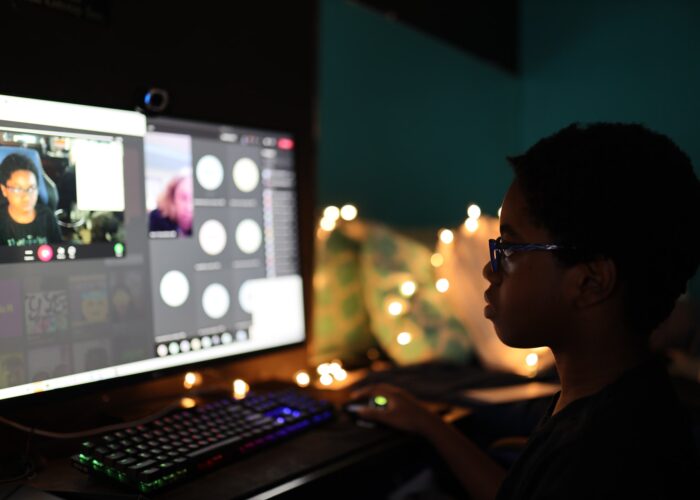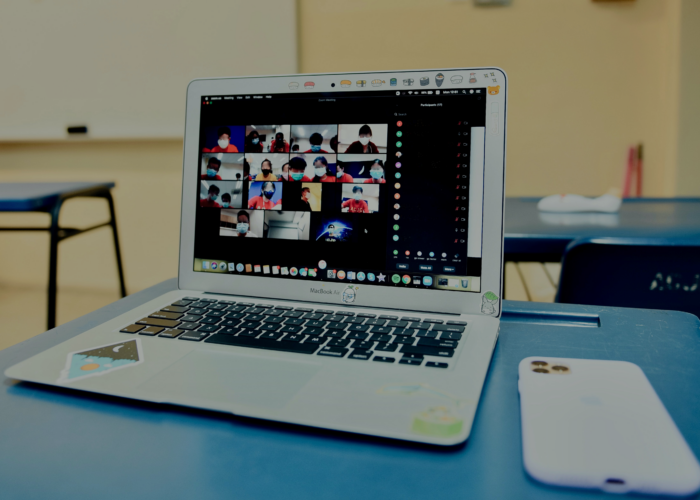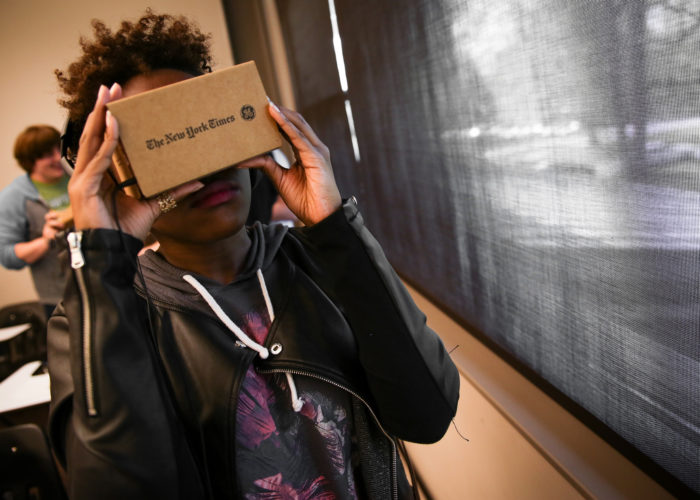We are now nearing the two-year mark of a global pandemic that has had such a profound effect on every aspect of our lives. As students, educators, administrators, and researchers, we have had to adapt our academic practice in ways that blurred the lines between our public personas and our private lives. We have had to learn about and embrace various forms of technology in order to enable remote teaching, learning, and collaborations, all with little control over the scale and extent of the invasiveness made possible by these technologies. It is at this crucial conjuncture that we offer this Themed Issue of the Journal of Interactive Technology and Pedagogy on surveillance and educational technologies.
As we said in the call for papers for this issue: “The COVID-19 pandemic has served as a magnifying glass, revealing all the ways our systems are broken.” Indeed, social fault lines have not only been exposed and exacerbated in the harsh light of the pandemic response, but even more so through the ways many institutions chose to ignore it while hoping to continue with some version of business as usual. But, just as a magnifying glass reveals faults, it shows us opportunities for repair: we cannot simply fix what is broken, but also must work toward eliminating systems that are not “broken” but working as designed—to the detriment of marginalized and vulnerable populations. Thus, while we develop counternarratives and critiques, we can also draw on more expansive visions of abolition, which demand “that we change one thing, which is everything” (Gilmore 2018).
Bluntly, many of these surveillance systems and computational tools shouldn’t exist. While the emergency circumstances under which people and institutions have adopted them during the pandemic make such developments somewhat understandable, now that we have a better understanding of the concrete consequences in our pedagogy and in our students’ lives, we really have no justification to continue using these tools in these ways. We must change not only the punitive technology we use, but the educational mindset and broader world that rationalizes it.
This issue is not the first, nor will it be the last, collection of such critical work, but as we spend more time within this pandemic paradigm, we are accumulating clearer and stronger evidence and narratives of the harms surveillance-oriented educational technology brings, making it much less understandable for justice-oriented educators to excuse their use. The pandemic has crucially highlighted the need for consent, compassion, and care, and one of the striking things about many of the pieces in this issue is that they are self-reflective rather than analytical. Many of the authors situate themselves in a fraught system of monitoring and punishment and analyze or question their roles in bringing potentially harmful surveillance to bear on others, especially the students they are meant to nurture. It’s also notable how many of these projects address remote proctoring and Learning Management Systems (LMSs). For many institutions, the pandemic supercharged the already pervasive use of LMSs and proctoring systems in the transition to remote instruction. As the uptake of these tools and protocols increased, so did the outcry around the invasiveness and consequences of their use. Consider these pieces both as scholarly research, and as a call to action for justice, within and beyond education.
In “Toward Abolishing Online Proctoring: Counter-Narratives, Deep Change, and Pedagogies of Educational Dignity,” Charles Logan invokes Audrey Watters’ notion of the “edtech imaginary” as a way of exploring how remote-proctoring companies develop powerful narratives about the necessity and usefulness of their products, and how we might establish counternarratives that move us closer to the abolition of these discriminatory technologies and their effects.
In “Back Doors, Trap Doors, and Fourth-Party Deals: How You End up with Harmful Academic Surveillance Technology on Your Campus without Even Knowing,” Autumm Caines and Sarah Silverman alert us to the dangers and complications of allowing fourth-party vendors access to institutional data through backdoors created by third-party relationships. With Proctorio as the primary example, they unpack these relationships in an accessible and clear way, while outlining the different kinds of fourth-party partnerships that institutions might unknowingly find themselves in. Caines and Silverman also lay out a harm index, a useful framework to measure the levels and scale of harms that remote proctoring services can cause. The authors include an example of their collaborative autoethnographic reflection, which provides a glimpse into the tedious but necessary steps needed to thwart corporate control over faculty and student data.
Jessica Kester and Joel Schneier’s “Soft Surveillance: Social Media Filter Bubbles as an Invitation to Critical Digital Literacies” discusses having students engage with the surveillance-derived filter bubbles of their own social media feeds in order to develop critical digital literacies—a way for students to “critically look at their digital practices through their own digital practices.”
In “Resisting Surveillance, Practicing/Imagining the End of Grading,” Marianne Madoré, Anna Zeemont, Joaly Burgos, Jane Guskin, Hailey Lam, and Andréa Stella assert that grading systems are an element of larger systems of surveillance at educational institutions and that grading is incompatible with antiracist pedagogies. They offer a variety of experiences where they either individually or collectively operated against or outside the schema of grading, and push us to “reimagine the purpose of schooling” in light of these struggles.
For Issue 20, we also wanted to create space to explore issues around educational surveillance that wasn’t constrained by the formality of more traditional journal articles, so we invited submissions to our Views from the Field section. We are very pleased to present five thought-provoking pieces that critically engage with the experience of being surveilled by educational technology and the potential consequences of this surveillance on our collective wellbeing.
We start off with “Why Don’t You Trust Us?”, a compelling piece from undergraduate student Sinéad Doyle, who generously shares her own experience of being subjected to additional surveillance during the pandemic and how this sort of invasive surveillance can blur the lines between public and private in counterproductive ways. Lance Eaton’s “The New LMS Rule: Transparency Working Both Ways” imagines what it would look like if we turned the tables and gave students the same level of access to instructor activity on LMSs as these platforms give instructors to student activity, noting the power imbalances built into conventional LMSs. In “Pedagogy and the Expansion of Surveillance at the City University of New York,” Marc Kagan continues the exploration of the potentially insidious nature of LMSs by pointing out the dangers of allowing unfettered and unregulated administrative access to online courses, highlighting the potential role of labor organizations in challenging this threat. “Black Mirror Pedagogy: Dystopian Stories for Technoskeptical Imaginations,” by Daniel G. Krutka, Autumm Caines, Marie K. Heath, and K. Bret Staudt Willet, provides a way to help students interrogate their own techno-optimism through the use of Black Mirror-inspired speculative-fiction narrative building. And finally, Chris Miciek’s creative text, “Field Notes from the Education to Employment Pipeline: A Career Development Perspective,” gives us a bird’s-eye view history of the contested imbrication of education and labor-market requirements, highlighting the historical and ongoing processes wherein students are inured to the use of technological surveillance in readiness for workplace surveillance.
In addition to the pieces on surveillance in education, we are pleased to include two general-interest articles before we pause publication for our migration to a new publishing platform.
The first, “Authoring an Open-Source Game for a Faculty Open Educational Resources Workshop: A Case Study” by Katherine Foshko Tsan, is an excellent piece on using Twine, an open-source interactive narrative building tool, for faculty development focused on OER. This piece highlights how using these sorts of narrative tools can be a compelling way to engage with faculty while opening new space for them to learn about OER.
Our second general-interest article, “Poetry in Your Pocket: Streaming Playlists and the Pedagogy of Poetic Interpretation” by Stephen Grandchamp, shares how the use of Spotify playlists made poetry more accessible to students and helped to recontextualize poetry in a more contemporary setting. This approach helped students understand and participate in the shifting meaning and significance of poetry, and gives hope for those of us who find interpreting poetry a little intimidating.
We want to acknowledge the patient and incredible work that managing editor, Patrick DeDauw, and editorial assistant, Chanta Palmer, have done to keep us on track and wrangle the many moving pieces that needed to come together to produce this issue. Our deep gratitude to the members of the JITP editorial collective for all their behind-the-scenes work and support. We also want to acknowledge the reviewers who took time out of their busy schedules to provide valuable feedback to our authors and note that it has been a privilege to be able to work with the authors to bring you Issue 20. We are deeply grateful that we were all able to come together during this pandemic to give shape and space to this important conversation, and we hope you will join us in doing what we can to ensure an equitable and surveillance-free educational future.







